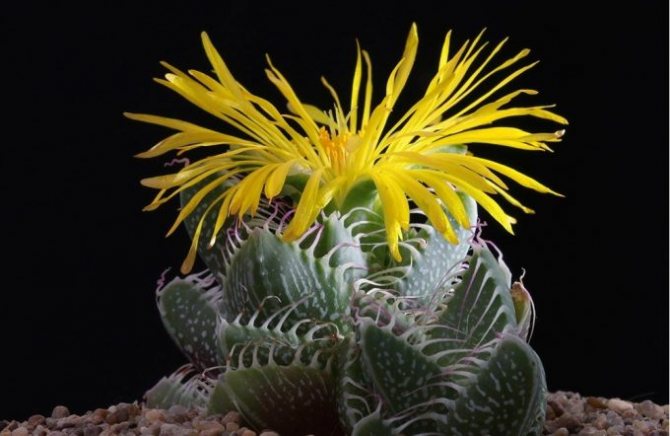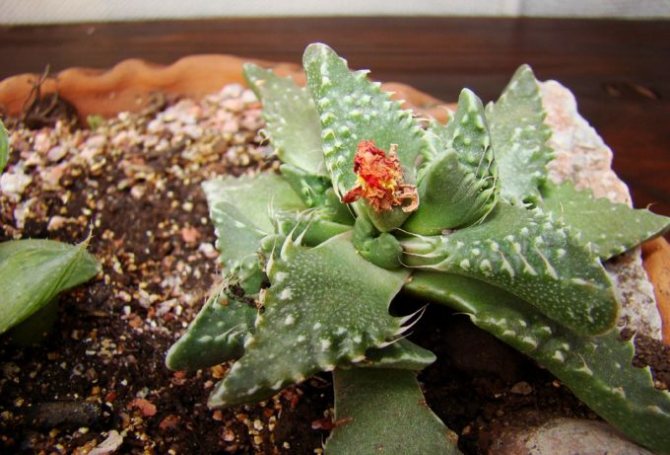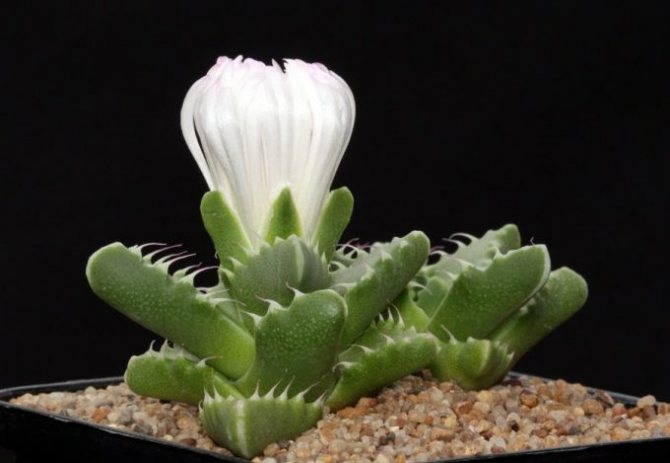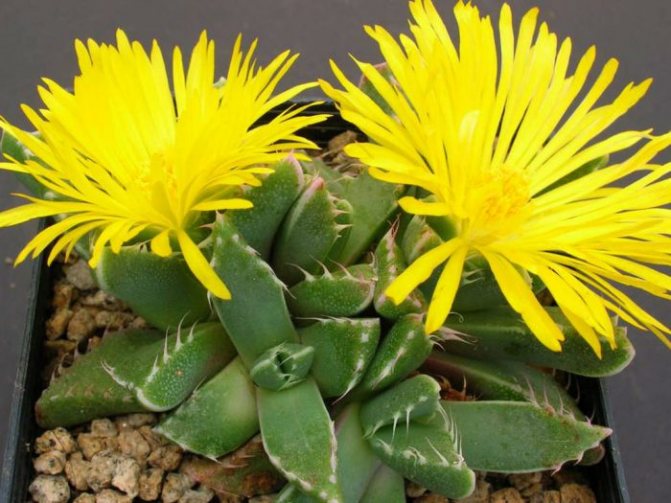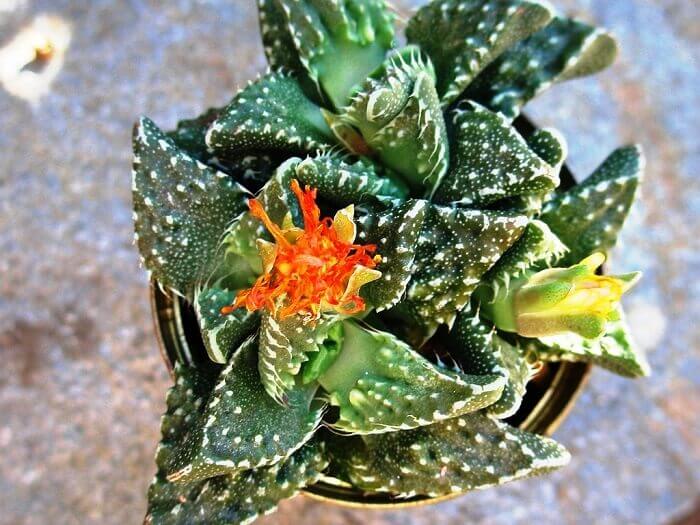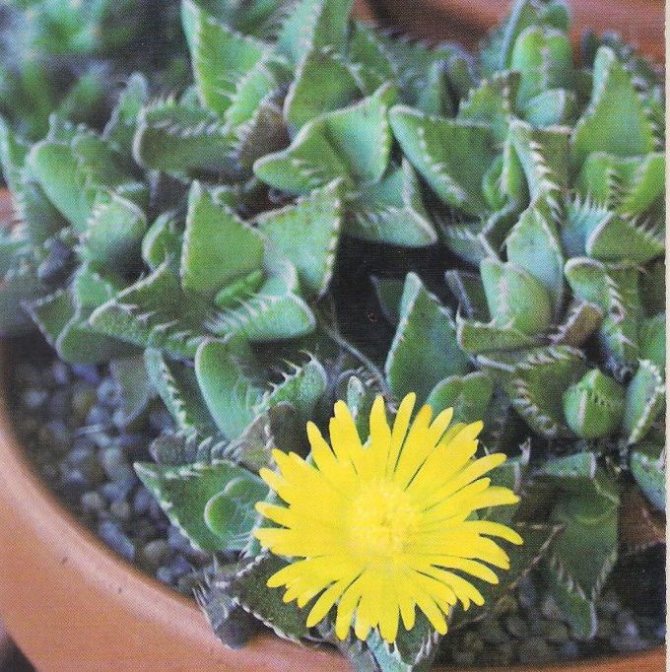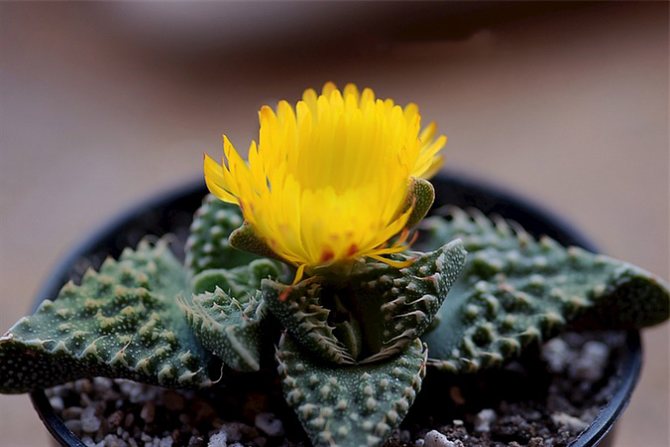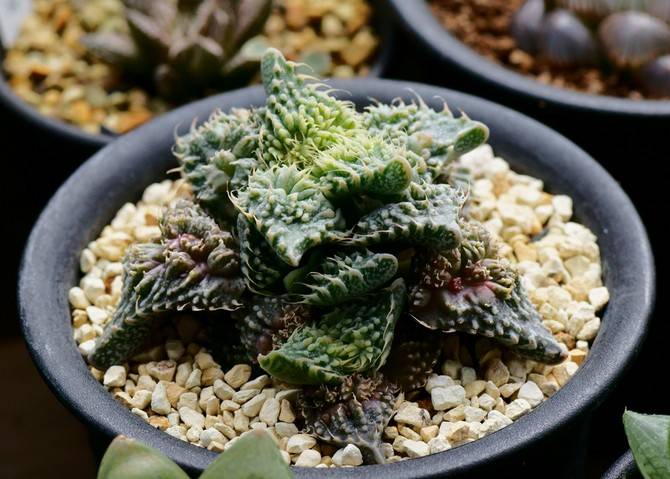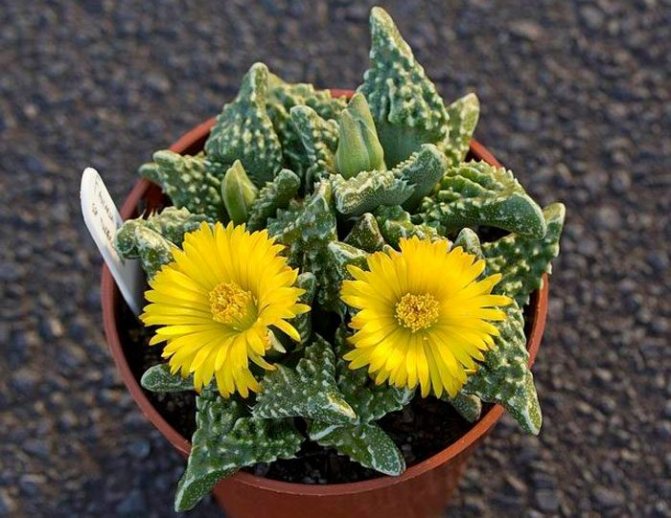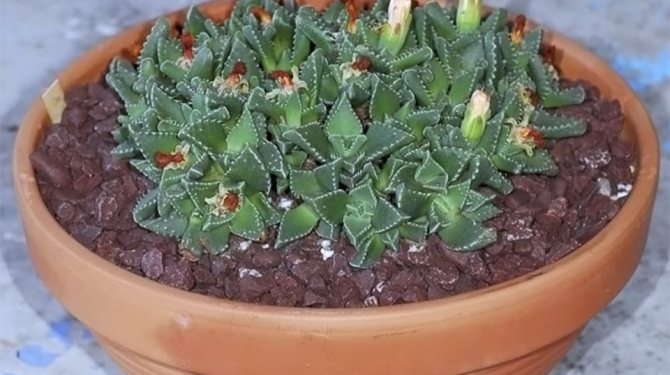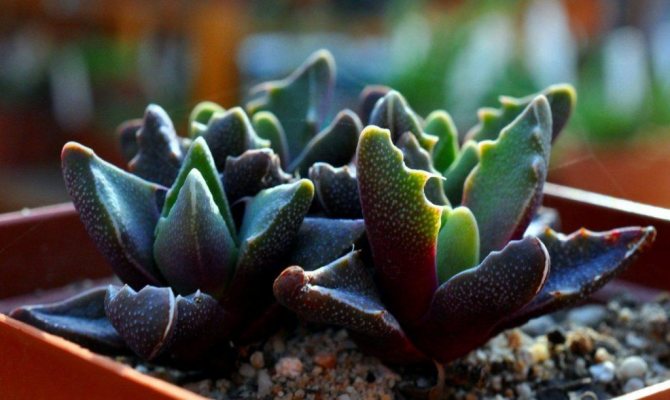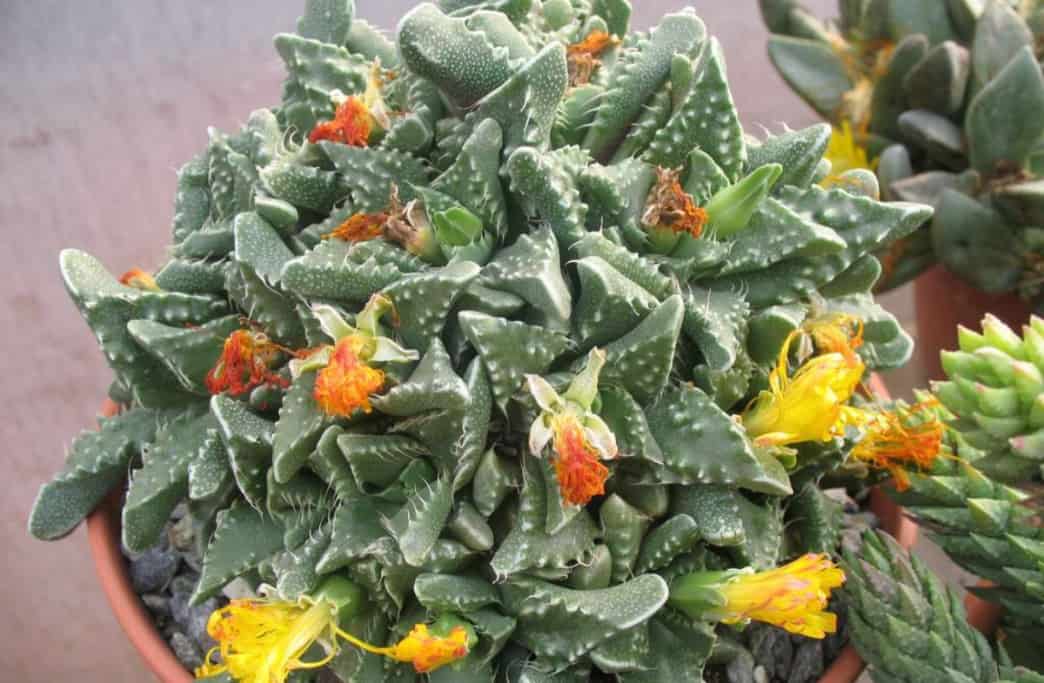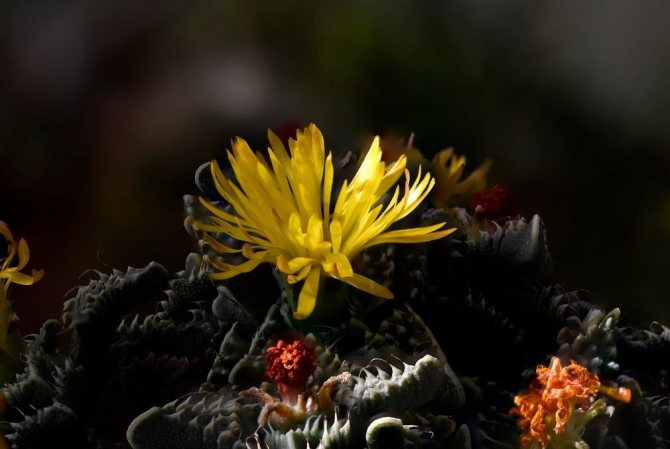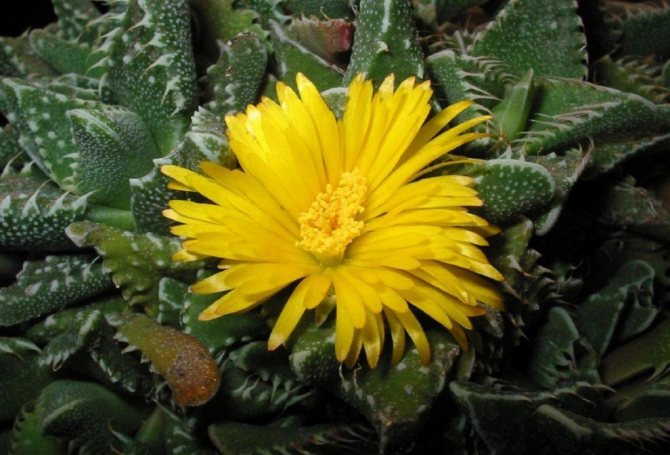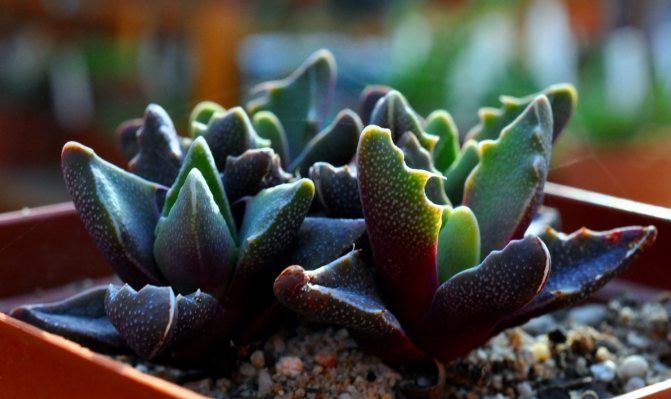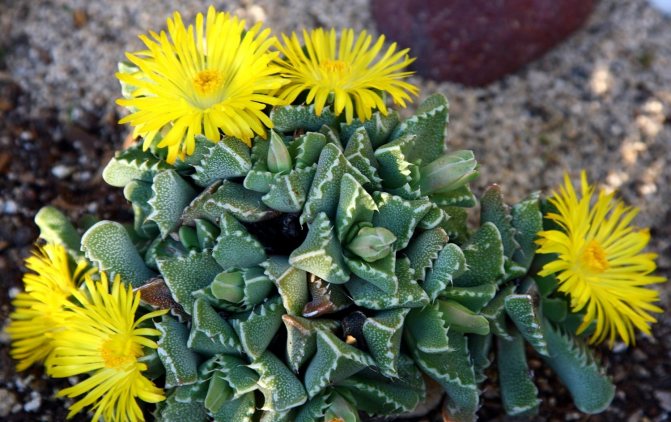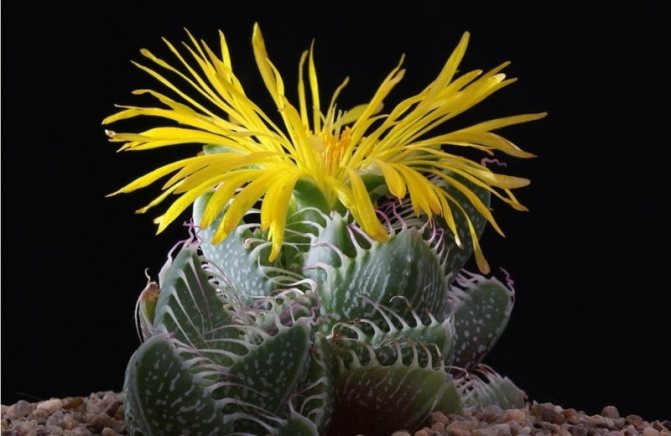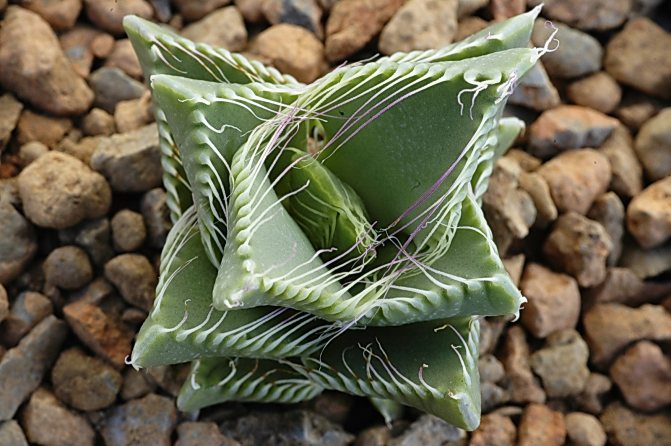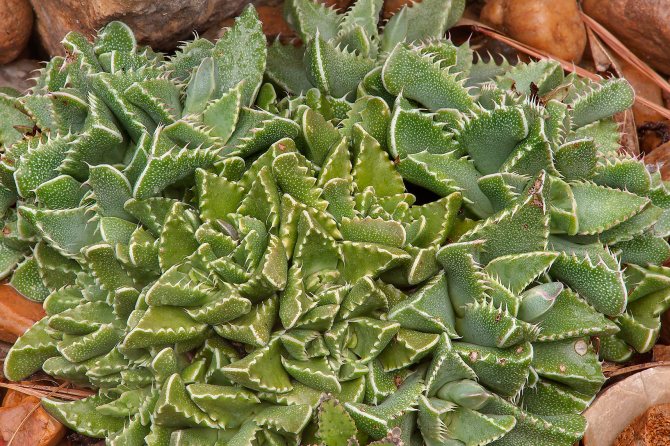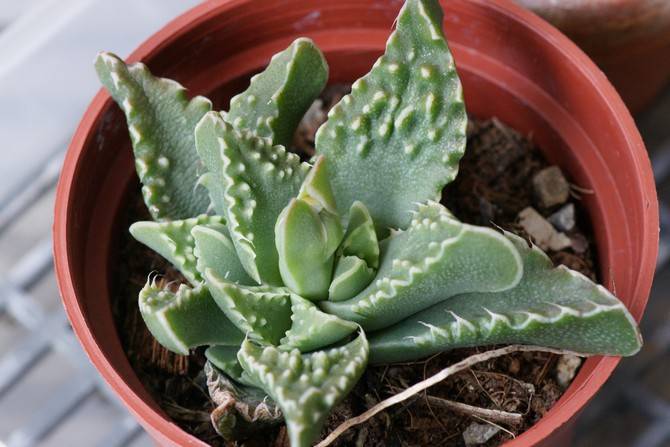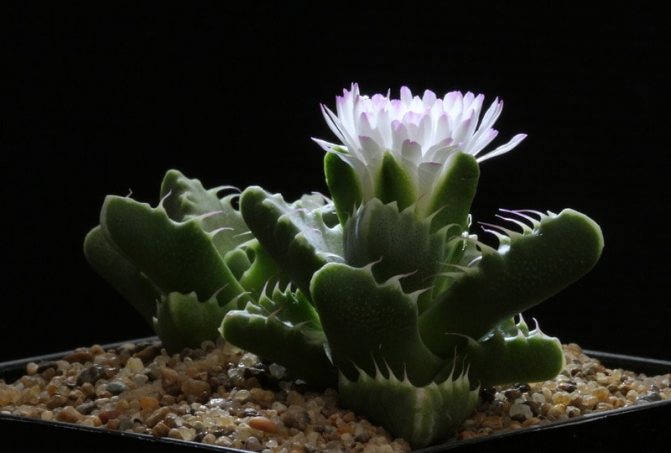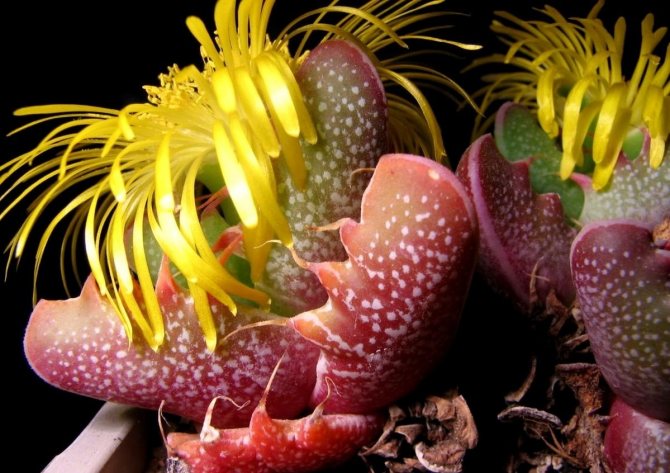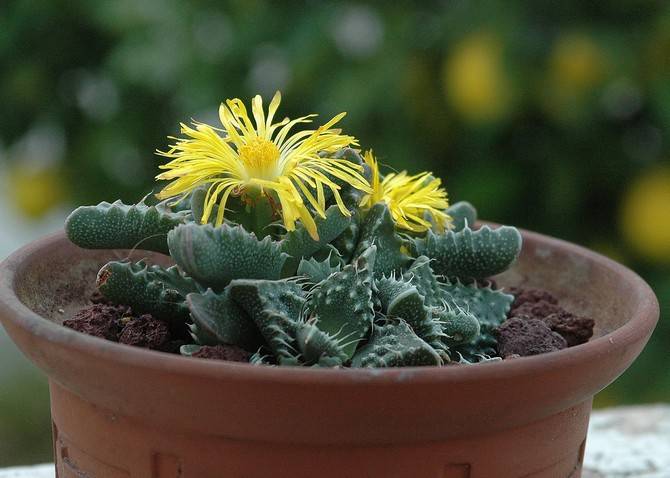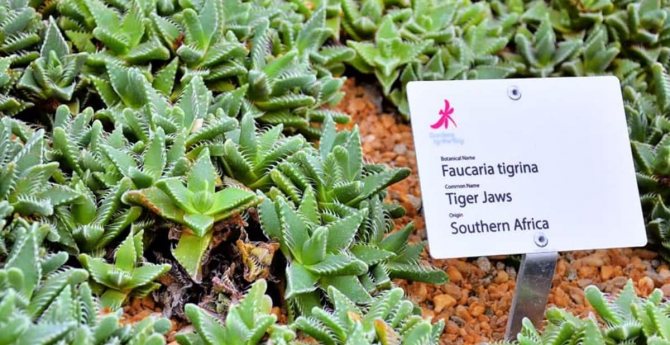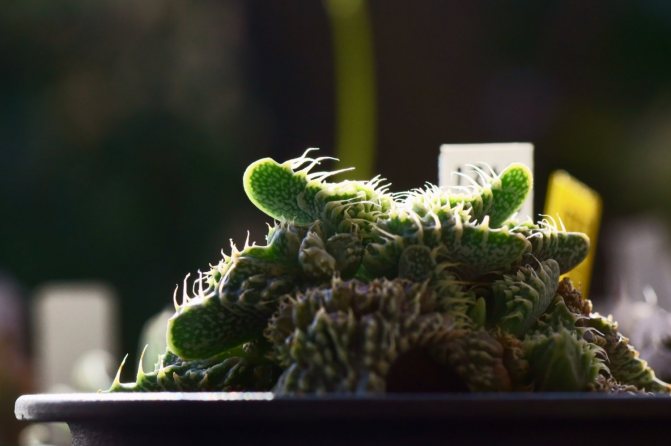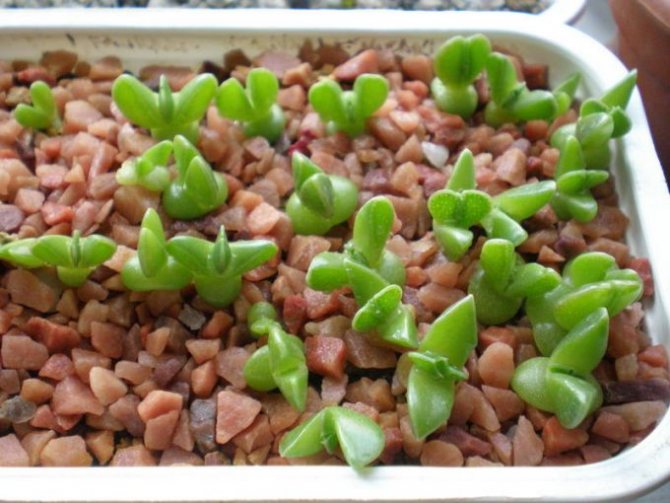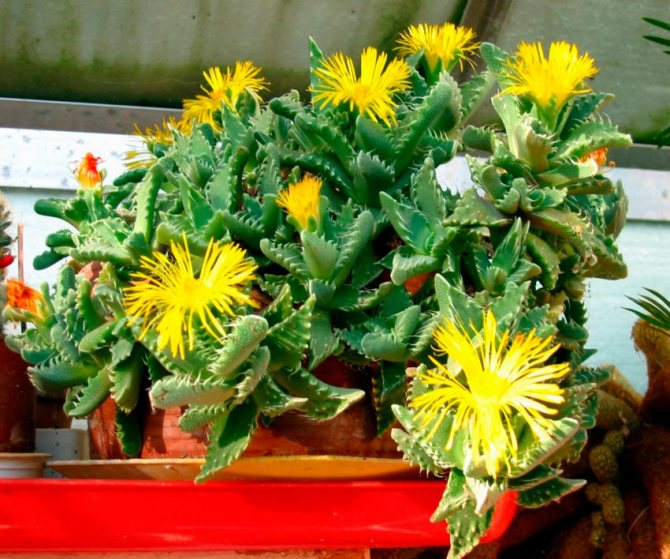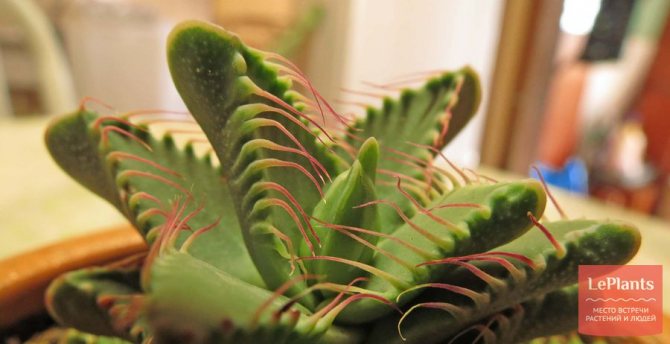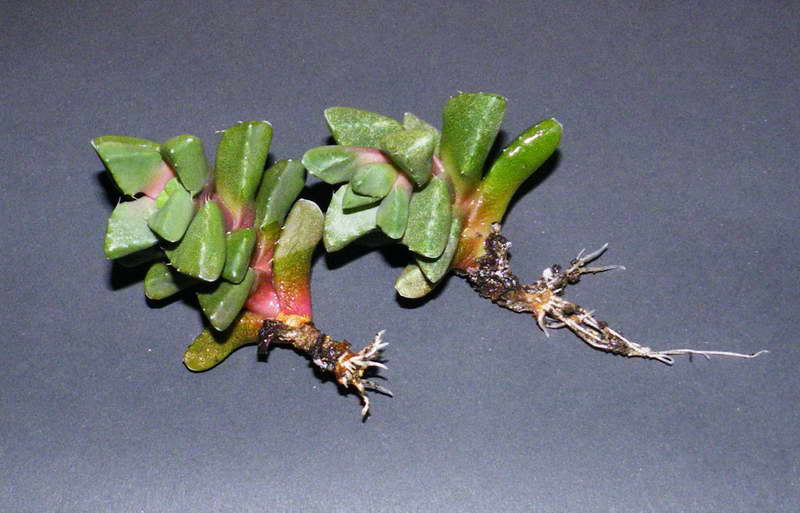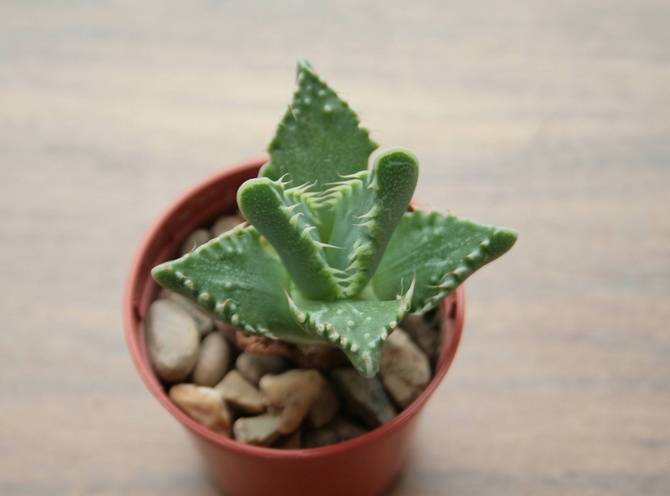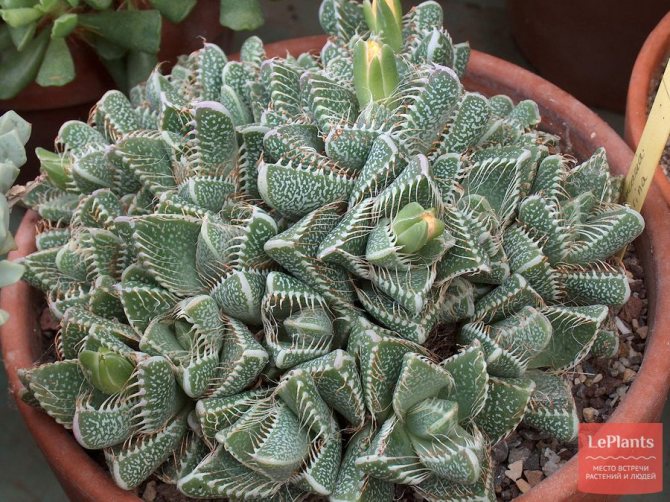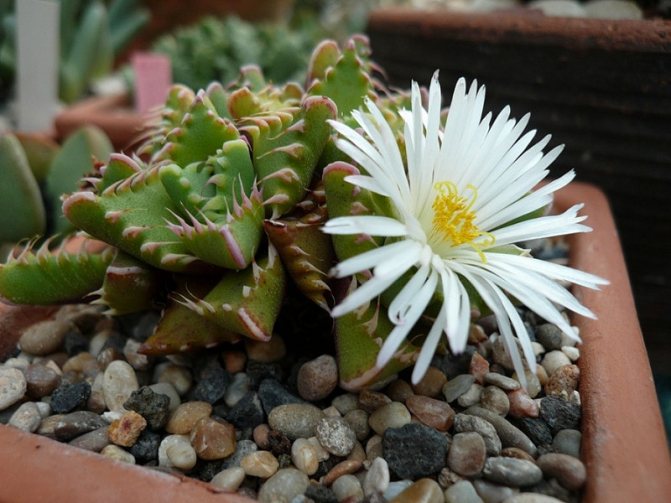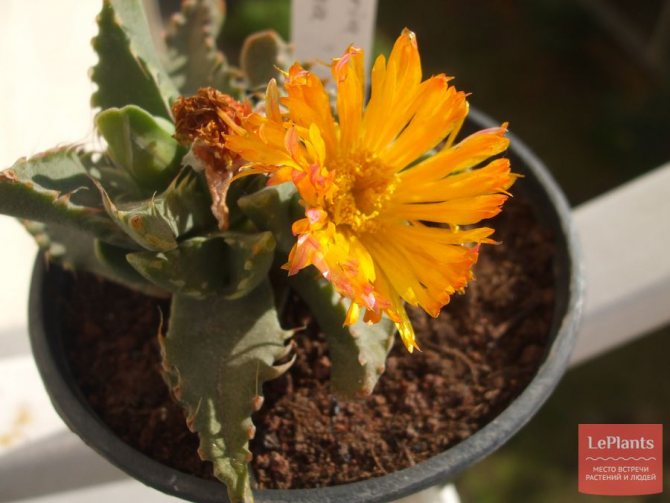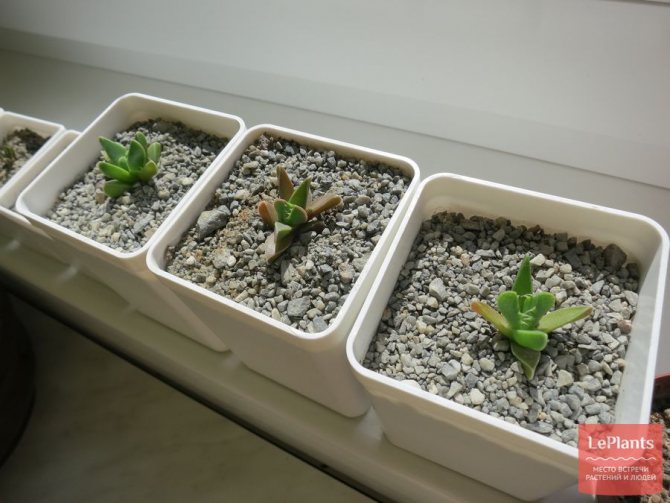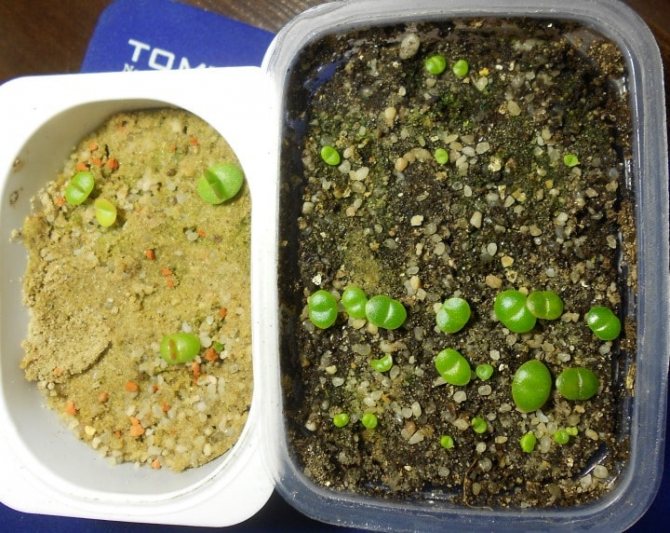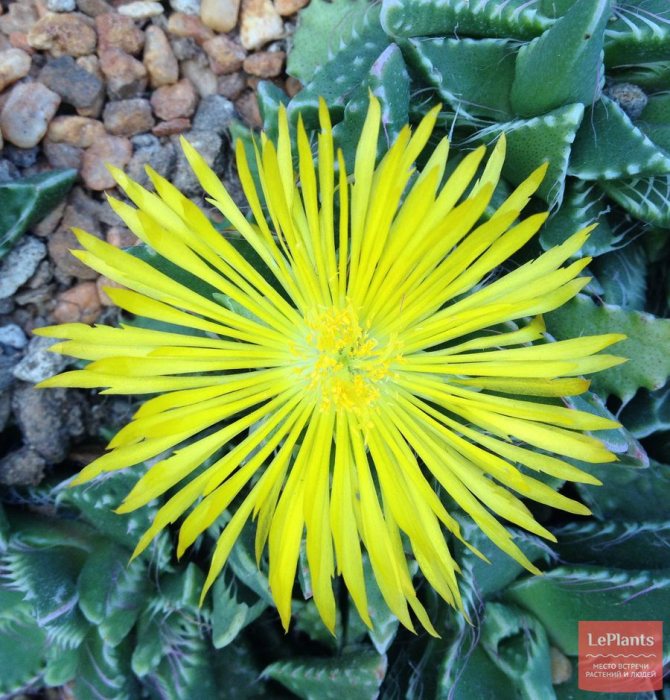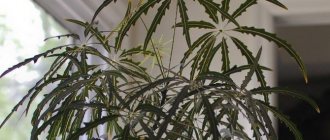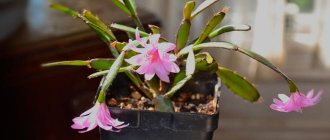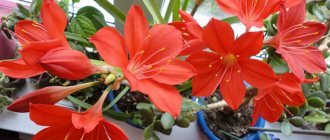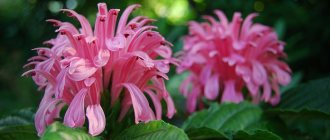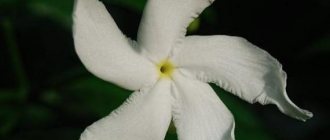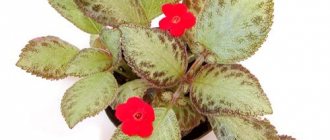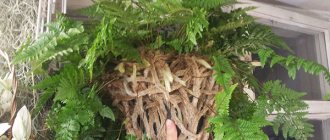Such a succulent as faucaria (Faucaria) is directly related to the Aizoaceae family. This plant comes from the arid regions of South Africa. Faucaria is translated from Latin "faux" - "mouth" and from Greek "αρι" - "many". This is due to the type of plant itself. So, its leaves end in spinous outgrowths, which are similar to the jaw of a predatory animal.
Such a plant is a perennial. It has a short fleshy rhizome and a shortened stem. As a rule, over time, it grows strongly and can form whole clumps, which include many stems. Each leaf rosette includes from 3 to 6 pairs of juicy and rather thick leaves, which are arranged crosswise. They can be painted in various colors, both dark and pale green, with whitish specks or strokes. Spinous outgrowths or hair-like teeth are located on the edges of the leaves. Single flowers are quite large, so their diameter can reach 6-7 centimeters. They have a large number of petals, which are colored in different shades of yellow. Blossoming of flowers occurs in the daytime, while at night they close. Each flower lasts about 6-8 days.
Leaves
Quite thick, up to 50 mm long, 15 to 25 mm wide. They are very close to each other, erect. The color ranges from green to gray-green. The shape of the leaves is triangular, ovoid-rhomboid in the upper part. The lower half is square. Above, the leaves are pointed and serrated. The keel and margins are whitish, jagged along each margin, with translucent soft spines slightly curved backward, thus resembling open jaws.
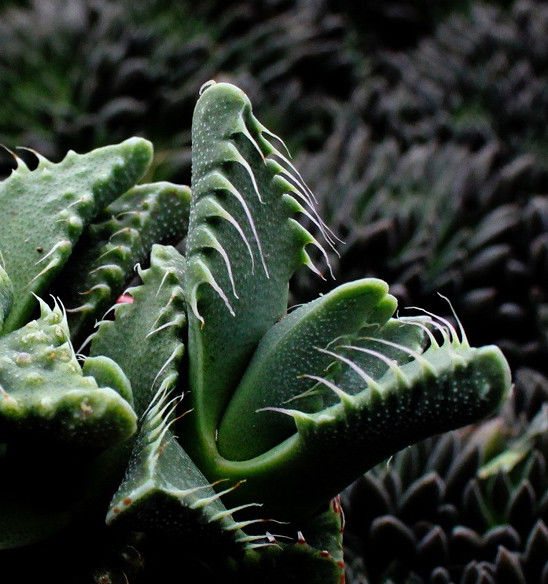
Above, the leaves of faucaria, the photos of which you can see below, are covered with a rough skin, with many white dots merging into larger spots.
Main types
Faucaria feline (Faucaria felina)
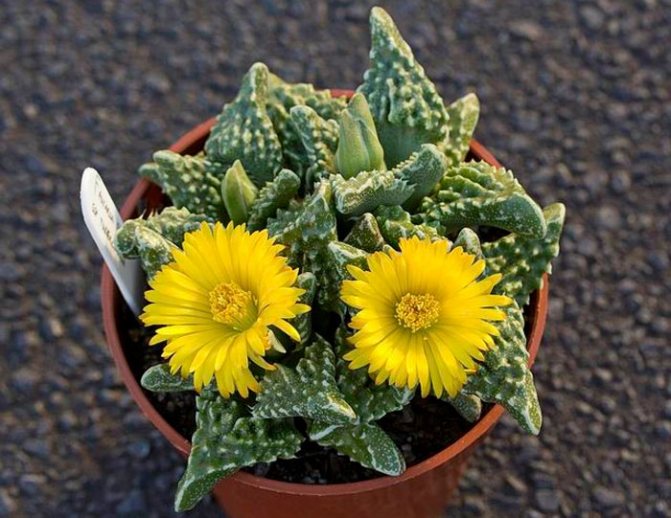

This succulent plant can reach a height of 10-15 centimeters. The leaf plate is about 5 centimeters long and 1.5 centimeters wide. Saturated green leaves are arranged opposite, cross-like. On their surface there are whitish blurred points, and on the edges there are 3-5 bent teeth, which turn into a bristle. Golden-yellow flowers reach 5 centimeters in diameter.
Faucaria paucidens
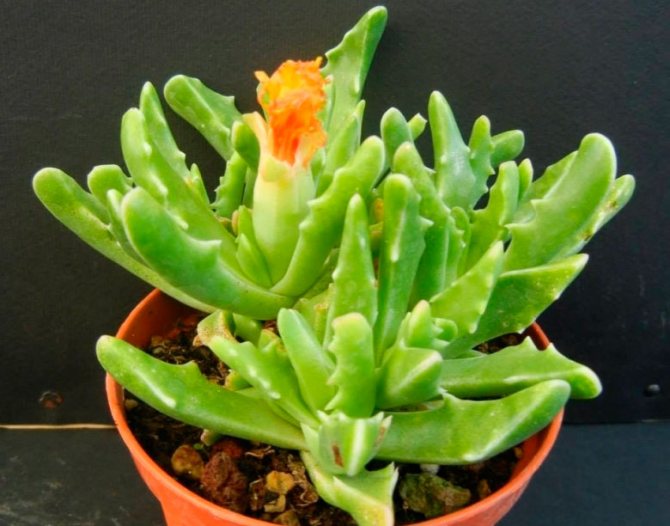

This succulent has pale green leaves that are 5 centimeters long and one centimeter wide. Dark green dots are located on the surface of the leaf plate, and there are from 1 to 3 denticles at the edges. The yellow flowers can be up to 4 centimeters in diameter.
Faucaria fine (Faucaria speciosa)
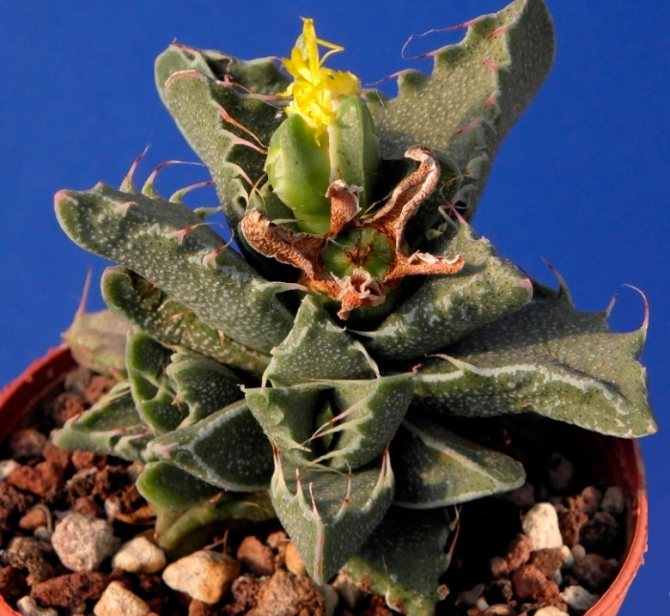

This succulent has fleshy leaves that reach 3 centimeters in length. Along the edge there are 5 or 6 teeth of a sufficiently large size, which turn into a bristle. The flowers are quite large, so their diameter is 8 centimeters. They are colored golden yellow, while the ends of the petals have a purple tint.
Faucaria tiger (Faucaria tigrina)
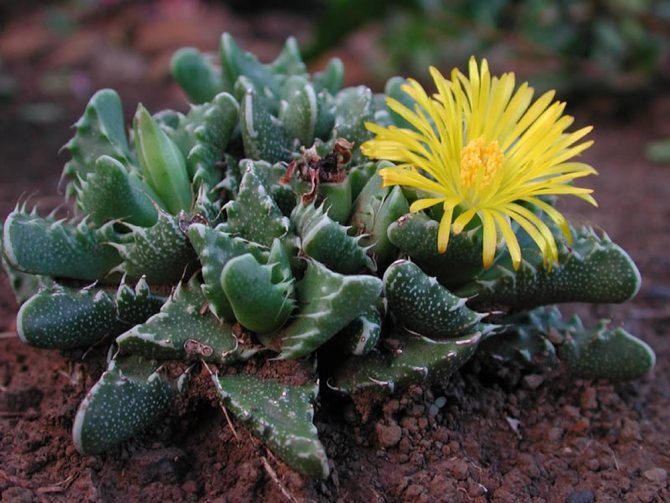

This succulent plant reaches a height of only 5 centimeters. Rhombic greenish-gray leaves have sharpening at the tips.On their surface there are many whitish dots arranged in stripes, while along the edges there are 9 or 10 pairs of strong teeth bent back, which have hair-like ends. Golden yellow flowers reach 5 centimeters in diameter.
Transfer
Faucaria is transplanted in the spring once every two years. For a flower, you should choose a wide and low container. Place a drainage layer on the bottom of up to a quarter of the total volume. To do this, you can use pebbles, expanded clay, clay shards, broken brick, and other similar materials.
You can independently prepare a loose soil mixture permeable to air and water or buy ready-made soil for succulents. Transfer the plant along with the earthen clod into a larger pot, being careful not to damage the root system, and add the missing soil to the sides.
After transplanting, the plant needs to be watered a little, and after the soil has settled, add a little more to it. Drain excess water from the pan.
Features of care and cultivation
Faucaria is an unassuming culture. There are certain subtleties of growing, but they are easy to learn.
- Lighting. Feels best on the south side. In the heat, it is better to remove from the window or shade with tulle - the sun's rays through the glass cause sunburn. The lack of light is painful - it stretches, turns pale, loses its decorative effect.
- Temperature. In the summer he loves warmth. Easily tolerates heat up to 30 ° C. Summer temperature drops do not affect the state of the faucaria. Peace and coolness is needed in winter. Maintain the temperature not higher than 10 ° C. Warm wintering leads to a weakening of the plant - it turns pale, stretches, does not bloom.
- Humidity. Favorable conditions - dry air of apartments. The air is not artificially humidified, faucaria is not sprayed. Excessive humidity leads to rot, wrinkling and blackening.
- Watering. Watering is rare, as the substrate dries up. Does not tolerate dampness of the soil. In winter, watering is completely stopped.
- The soil. Shop soil suitable for succulents. Self-made soil mixture is prepared from sand, turf and leafy soil. The soil should be loose, absorb and drain water well, breathe.
- Top dressing. Fertilizers are applied from mid-spring to late summer. Frequency - once a month. Use preparations for succulents. Lack of top dressing leads to slow growth, crushing leaves, discoloration.
- Transfer. The procedure is carried out in the spring at intervals of 2-3 years. Frequent transplants harm the plant.
Advice! Choose a pot that is wide and shallow. Fill it by a third with drainage - river pebbles mixed with fine expanded clay, brick chips, sand. To increase the decorative effect, faucaria can be grown in the same pot with other succulents.
Growing from seeds
Faucaria seeds should be sown in the spring in wide containers - seedling boxes, plastic containers with lids, any flat container with wet sand. Spread the seeds evenly over the surface of the soil, sprinkle them on top with a thin layer of sand. Cover containers with lids, glass, or plastic wrap. Place them in a place with diffused lighting. For seedlings, a comfortable temperature is from + 20 to +25 ° C. Open the shelter for half an hour daily for ventilation. When the substrate dries a little, spray it with a fine spray.
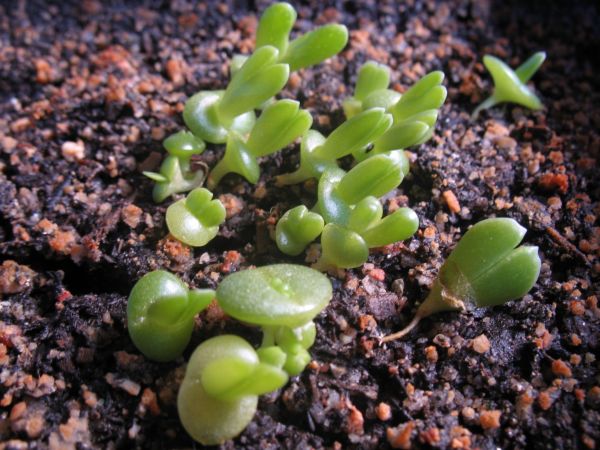

In two weeks, the first shoots will appear, after which the shelter can be removed. After the appearance of two true leaves, the seedlings can be planted in separate containers with a substrate for adult plants. Seed propagation allows you to get several new plants at once, however, it will require accuracy and patience from you. Plants from seeds grow more resistant to pests and diseases, although they bloom much later than those grown from cuttings.
Faucaria species and varieties
Faucaria tiger is the brightest representative and the most popular species in cultivation. This variety is about 5 cm tall. The rhombus-shaped foliage ends with sharp thorns. The shade of the leaves is light with many light small specks, which are arranged in stripes. The inflorescences have a rich sunny shade. The size of the inflorescence is approximately 5 cm in diameter.
Cat faucaria, this variety, reaches a height of 15 cm. The foliage is about 5 cm long and up to one and a half wide. The arrangement of the leaves is cruciform. Olive shade with beige splashes. The leaf edge has about 5 teeth. Inflorescences are whitish yellow.
Vegetative propagation
From early spring to mid-summer, leafy cuttings can be rooted. Use a scalpel or a sharp, pre-disinfected knife to cut the cuttings. Sprinkle the place of the cut on the mother plant with wood ash, and the cutting should dry out a little, the cut should be tightened with a film. After that, immerse it with its lower part in "Kornevin" and plant it in sand or wet vermiculite, slightly pressing it into the soil. Support it with a match to prevent your seedling from falling. Place on a south window and water a little. After three weeks, the seedling will take root and grow. Then transplant it into a permanent container of succulent soil.
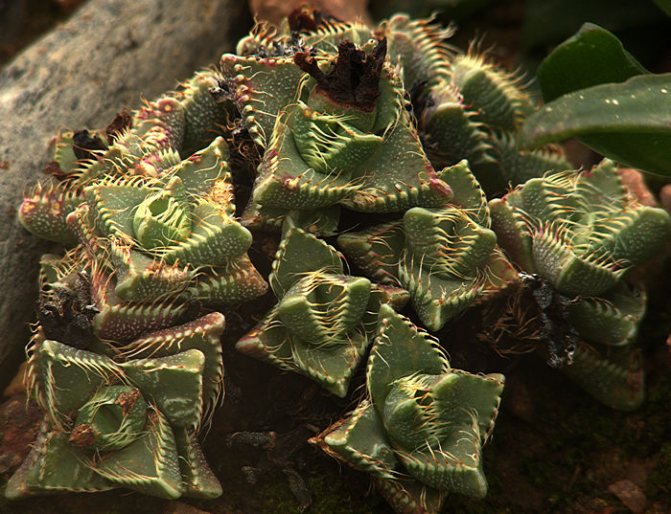

Description of popular Faucaria species with names and photos
Tiger (Tigrina)
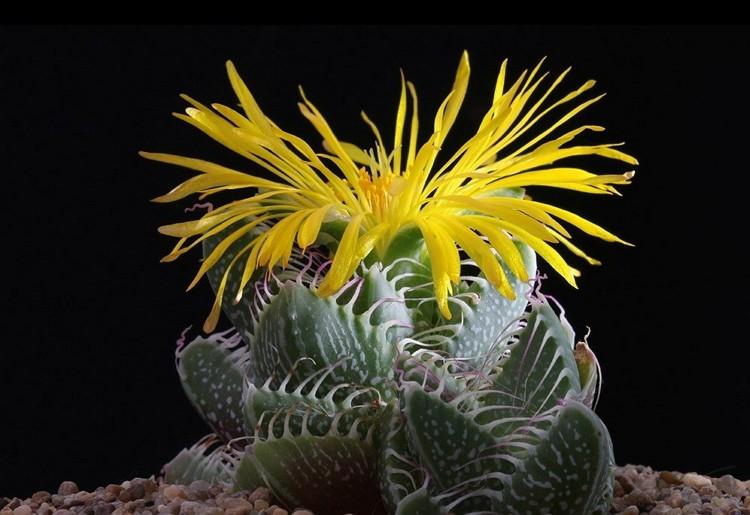

One of the most common types of faucaria for home keeping. Faucaria tigrina has a thick stem, up to 5 cm high. The leaves of the plant completely hide the shoot and have many light short teeth at the edges. When blooming, one sandy-yellow flower is formed, 5 cm in diameter.
Bosch (Bosscheana)
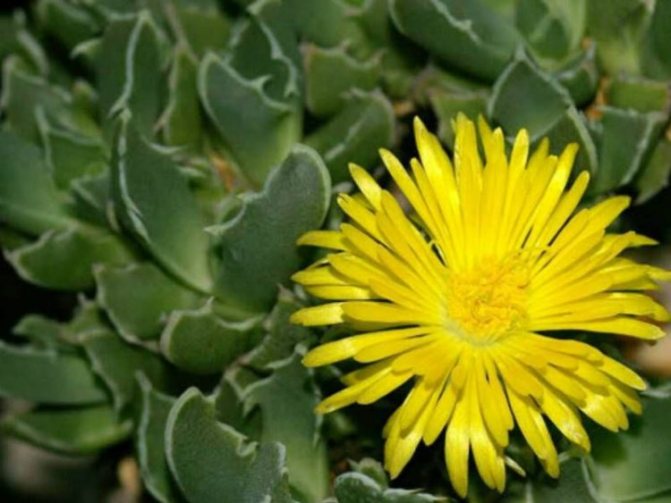

The thick leaves of Faucaria bosscheana are up to 5 cm long. It is a small shrub with large yellow flowers 4-5 cm. The leaves are also covered with thorns and are slightly concave inward. This species of faucaria blooms in autumn.
Feline
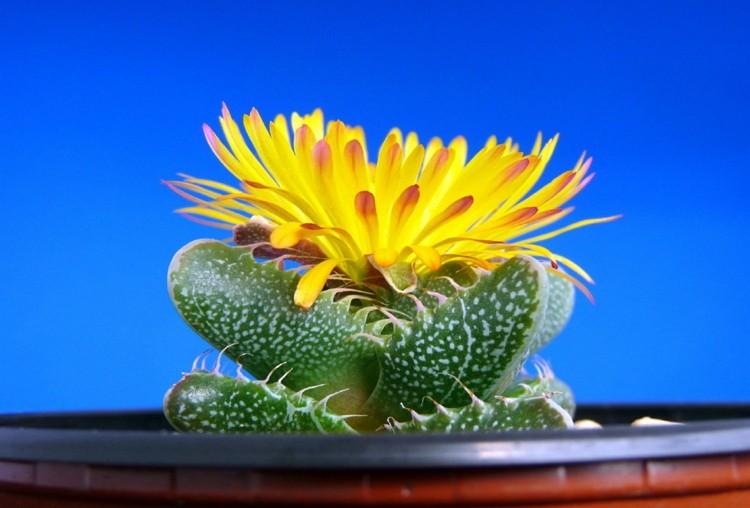

The largest plant species, reaching 10-15 cm in height. At the same time, the dark green leaves of the succulent are covered with thorns not only on the sides, but also in the center. In this way, they resemble cat's tongues, which is why they deserve their name. The flowers of the plant are sunny and fluffy, composed of needle-like petals.
Small toothed (Paucidens)
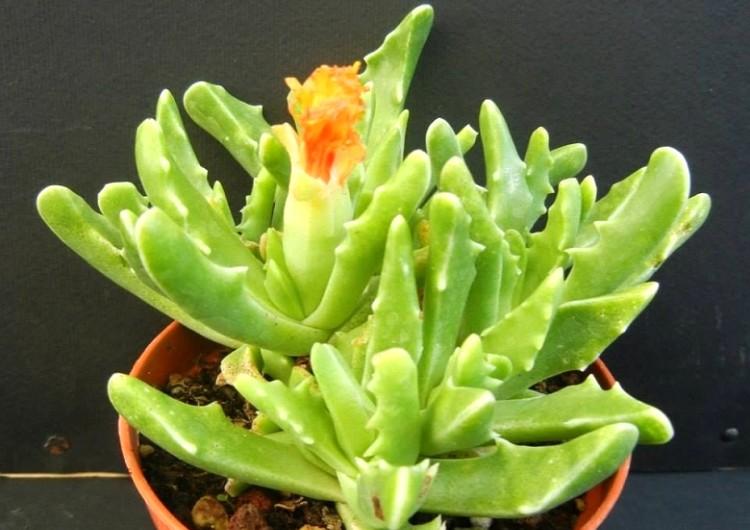

The leaves of this plant are pale green in color, reaching 5 cm in length. The leaf plate is covered with dark green dots and is equipped with several denticles at the edges. The yellow flowers of the succulent do not reach more than 4 cm in diameter.
Lumpy or Warty (Tuberculosa)


A succulent of this species can reach 8 cm in height, but at the same time it has a branching stem. The leaves are dark green, serrated and fleshy and grow together with the base. The shape of the leaves is rhombic or triangular, with whitish blotches on the surface. The flowers of the plant are also yellow.
We recommend watching a video about the peculiarities of the flowering of the Warty Faucaria:
Candida
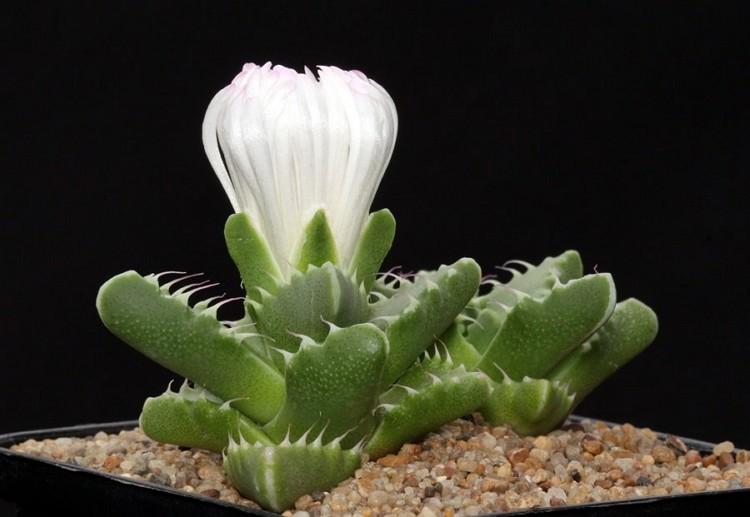

Outwardly, the Candida faucaria is very similar to the tiger species. The only striking difference of this species from the rest is the presence of large snow-white flowers during flowering.
Diseases and pests
This plant is resistant to pests and diseases, but sometimes the succulent is attacked by spider mites, mealy or root bugs. To combat them, you should wipe the leaves with a soft brush dipped in a solution of Aktara insecticide.
When a root worm is found, the flower must be removed from the pot, shaken off the roots and rinsed in an insecticide solution. Then it should be rinsed in water. After that, the roots are dried and the plant is planted in dry new soil. Watering only the plant after two weeks.
Botanical characteristic
Note: Faucaria is a perennial succulent from the Aizov family.For the shape of the leaves, faucaria is popularly called the wolf, tiger or cat's mouth.
This genus of succulents has 33 species and 4 varieties. The maximum height of the succulent reaches 10 cm. Dense rosettes of fleshy leaves form on the surface of the pot. The foliage is arranged crosswise. The plant rarely blooms, but if this happens, then the flowers are single, small, up to 3.5 cm in diameter. They are white or yellow in color with a golden sheen, depending on the type of succulent.
Faucaria lives in the driest regions of South-West Africa, in the Cape Province. The annual amount of precipitation there is only 200-300 mm, and the average daily air temperature in summer exceeds + 50 ° C.
Description
Faucaria, like all plants of this family, is a perennial, with a small fleshy root and a short stem (sometimes without it)... The maximum height of the bush is 15 cm. Over the years, with proper care, it grows and forms islands (clumps), giving many stems and covering all the free space in the pot. The rosettes consist of juicy fleshy dense leaves, concave-triangular in shape. Their number varies from 3 to 6 pairs. Their color ranges from pale to dark green, monochromatic, or with whitish strokes or specks and a waxy coating. Depends on the variety. The leaves are arranged in pairs in the form of a cross. Some are covered with raised growths, and at the edges are hooked with villi at the tips. Leafy rosettes originate from tubercles that appear on the stem.
The plant blooms in summer. Flowers are single, multi-petaled, needle-like, large, from 5 to 7 centimeters in diameter, painted in all shades of yellow, located in the center of the rosette. They bloom during the day, curling up at night, for a long time they live in the form of buds, but in bright light they show their beauty. Lack of lighting is a signal to close. The duration of the flowering phase is from a week to ten days.
Similar succulents
There are several succulents very similar in appearance to faucaria.
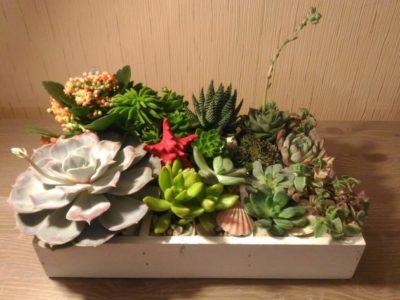

Haworthia Is a small rosette succulent plant from South Africa. It is a stiff-leaved or herbaceous plant with green leaves that have cilia at the edges of the leaf plate;- Rejuvenated - a beautiful succulent from Southwest Asia, with a natural symmetry of the arrangement of the leaves. The plant is perfect for planting spectacular compositions from different types of this succulent.
- Echeveria - "stone rose" from Central America. A succulent plant with a short stem or none at all. The plant has dense rosettes of leaves at the ends of the shoots.
- Aptenia - succulent from South America with a fleshy stem and opposite heart-shaped leaves. At the ends of the lateral shoots in the leaf axils of the aptenia there are small red flowers.
- Argyroderma Is an evergreen succulent from Africa and the Peruvian desert. By its appearance, the plant resembles sea pebbles, collected in small groups. The leaf rosette contains 2-4 fleshy greenish-gray leaves of a semicircular shape, half fused together.
1. Seven Secrets of Success:
| 1. Growing temperature: Faucaria can be grown during the growing season at temperatures from 21 to 30 ° C during the growing season, lower the temperature in the winter months to 16 ° C. |
| 2. Lighting: Shade from direct sunlight during the daytime in spring and summer. A succulent plant can bathe in the sun in the morning and evening for 3-4 hours daily. |
| 3. Watering and humidity: between waterings, dry the soil 3 to 5 centimeters deep in spring and summer. In the fall and winter, keep watering frequency to a minimum by simply protecting the potting medium from completely drying out. It tolerates a dry atmosphere well and does not need additional air humidity. |
| 4. Features of the: faucaria is extremely unpretentious and is only afraid of too high humidity. |
| 5. Priming: can be poor in nutrients, but has excellent drainage. |
| 6. Top dressing: in the warm season, every month the flower is fed with mineral fertilizers for succulents and cacti. In the winter months, feeding is stopped. |
| 7. Reproduction: rooting stem cuttings in the warm season, seeds sown in spring, dividing large plants during transplantation. |
Botanical name: Faucaria.
Family... Aizovs.
Origin... South Africa.
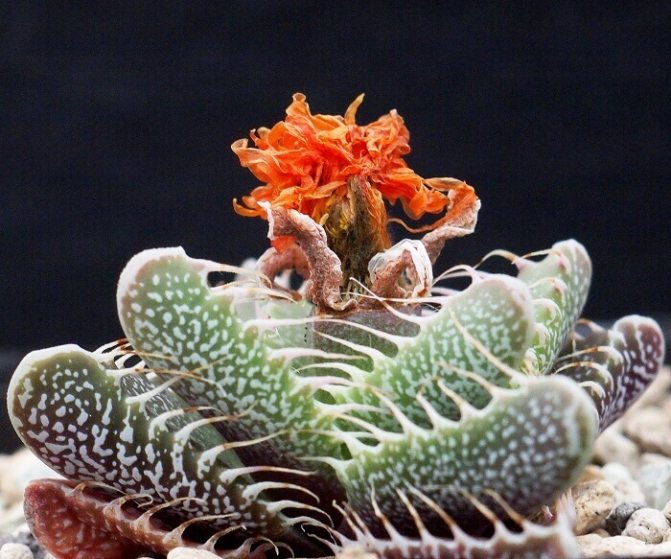

Description... Faucaria is a succulent, perennial, evergreen, miniature plant. The short, thick stem bears pointed, triangular, green leaves about 2.5 cm long, located opposite, in pairs. The fleshy leaves of the faucaria are used to store moisture reserves. The edges of the leaves are equipped with denticles, from which long light spines often appear. On the side, the leaves with protruding spines resemble the jaws of a predator. The flowers are typical for most plants of the family Aizovye - yellow, with a large number of long thin petals, up to 4 - 6 cm in diameter, open in the daytime. Each flower remains open for a week. There are plants with white or pink flowers.
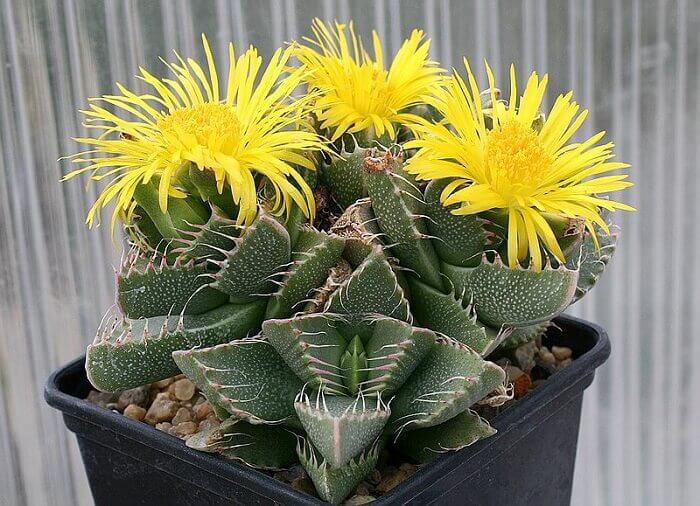

Height... Up to 6 cm.
Faucaria varieties
All types of faucaria are similar, but they have slight differences. The following varieties are especially popular among florists.
- Feline. Quite high - up to 15 cm, the length of the leaves - up to 5 cm. The rosette is bright green, on the surface there are blurry white blotches. Up to five bent teeth along the edges, soft bristles at their tips. The flowers are not large - about 5 cm, the color is golden yellow.
- Small toothed. The rosette is light green, covered with darker specks. The number of teeth at the edges is no more than three. Flowers up to 4 cm in diameter, yellow.
- Beautiful. The leaves are fleshy, short, with up to 6 large teeth at the edges. The flowers are large - up to 8 cm, yellow in the center, purple at the edges.
- Tiger. A compact plant no higher than 5 cm. Leaves in the form of a rhombus pointed at the tip. The color is gray-green with whitish blotches merging into stripes. There are many teeth - up to 9-10 pairs.
- Lumpy. Low - 5-8 cm. Branching stem. Leaves in the form of rhombuses or triangles, grow together at the base. The color is dark green, white warts are scattered over the surface.
Advice! Faucaria is sold in specialized stores all year round. But it is better to wait for summer and buy a succulent plant in bloom. When buying, carefully examine the faucaria - there should be no traces of rot, plaque on the stems and leaves.
Outdoor cultivation
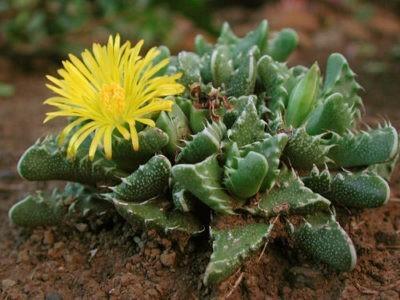

Succulents require a lot of sun. When planted in open ground in the shade, the plants stretch out, lose their color and waxy coating, and then rot and die.
In addition, plants of these species do not tolerate stagnant moisture. The soil for succulents should be scanty and rather coarse in composition, with a high content of sand.
For breeding faucaria in the open field, an alpine slide with a slight slope is suitable. Then, after winter, when the snow melts, the water will not stagnate, but will immediately go into the ground.
Faucaria for open ground is poorly suited. It is better to choose other types of succulents for the alpine slide, less thermophilic, and grow faucaria at home.
Curious facts about faucaria
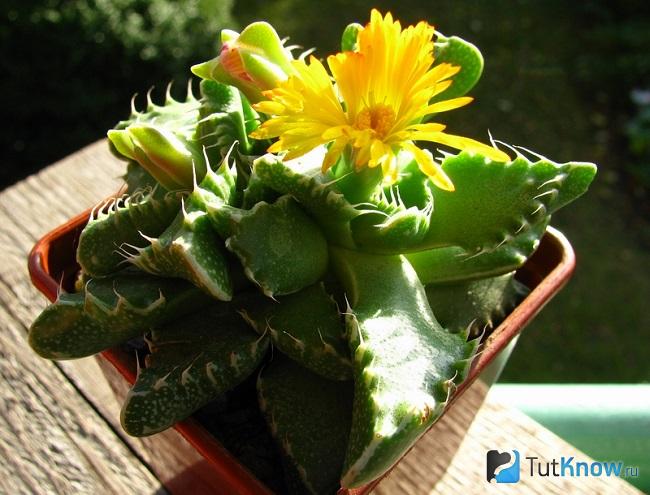

It is interesting that such an exotic plant as "cat's mouth" is suitable for people who were born under the sign of Scorpio. It is this sign that favors representatives of the flora, which have thorns and the ability to accumulate moisture in their parts. But faucaria can also be grown by people who are distinguished by their telepathic gift, the ability to see prophetic dreams and who want to achieve even greater perfection on this path. The plant will contribute to the understanding of the hidden processes taking place in space, will give the owner the strength to realize the invisible factors that affect his entire existence.
Plants neighbors of the "wolf's mouth" can be agave, scarlet, various cacti, ehmeya and kalanchoe, here also include common oleander and captive ginura.
Description of the flower
This is a low-growing perennial succulent, "decorated" by nature with speckled leaves and spectacular single flowers. The root is a short, succulent and fleshy rhizome.The stem is shortened. Over time, the shoot branches out, forming clumps. The leaves are thick, juicy, paired, arranged in rosettes, paired and crosswise.
The color of the leaves varies from light to dark green with mottling or dots, sometimes wartiness. Along the edges of the leaves are hard and thin outgrowths that resemble the "teeth" of predators.
The flowers are single, in comparison with the plant itself, large, multi-petal, painted in numerous shades of yellow, white. The flower buds close in the evening and invariably open in the morning. Flowering lasts 1-2 weeks.
Bloom
With proper care, faucaria blooms in the summer, in June-July. Flowering continues for about two weeks. At the same time, flowers open in the morning and close in the evening. Faucaria blooms only in bright sun, and in cloudy weather the flowers remain closed. From the central part of the rosette, 1-5 flowers bloom, painted yellow with a glossy surface.
Why doesn't it open the buds?
Most often, succulent flowering problems are caused by mistakes in care. The main factors are a lack of light, a violation of the temperature regime or improper moisture. The main mistake of novice florists is abundant watering during the winter. Give the plant a lot of light and it will delight you with its sunny flowers every year.
[collapse]
Faucaria home care


Illumination level.
The illumination should be bright, therefore, the bush is placed on the window with a south orientation. With a lack of lighting, the sockets with leaves will cease to be dense.
Temperature conditions.
The best temperature regime in summer is twenty five to thirty degrees. Do not forget that in summer faucaria can withstand any temperature fluctuations. In winter, the plant needs a cool temperature (about ten degrees).
Humidity level of the air.
The plant can easily grow with low moisture content. There is no need to moisten it additionally. For hygiene, systematic wiping of the leaves is required.
Watering.
In the spring and summer season, watering is carried out in moderation. Watering is necessary only after the substrate is completely dry. Small amounts of watering are carried out in autumn. In winter, the plant is not watered.
Fertilization.
Faucaria is fed on April-August days once every four weeks. For this purpose, a complex for cacti is used.
Transplanting.
The bushes are transplanted once every couple of years. A suitable substrate should be loose and well breathable. To prepare a nutritious substrate, sod and leafy soil and river sand are combined in a 1: 1: 1 ratio. Store-bought potting soil is also suitable for succulent plants and cacti. The pot should be short but wide. At the time of planting, a good drainage layer is laid on the bottom of the container.
Reproduction.
Reproduction methods: using shoots, seed method.
Sowing seeds is carried out on the surface layer of coarse sand, and they are only lightly sprinkled with earth. The container is covered with glass on top. The optimal temperature regime is twenty to twenty five degrees. The sand should not dry out; for this purpose, it is sprayed in a moderate amount. The first shoots will appear in a week and a half. Plants dive after the first pair of true leaves has appeared. For planting, soil is used for cacti.
The stalk is separated, remains on the street for two to three days to dry out. After which it is planted in the sand, while maintaining a fairly high temperature regime - twenty-five to twenty-eight degrees. The plant will fully take root in three to four weeks.
Harmful insects and diseases.
Faucaria is immune to disease and harmful insects. If the bush is weak, then it can be attacked by aphids or root mealybugs.If it is illiterate to care for the plant, then gray rot may appear.
Problems.
The leaves turned pale, the shoots were stretched out - a warm winter, poor lighting.
Wrinkling, blackening of the leaves - too voluminous watering (especially in the winter season).
Fading, wrinkling, small size of leaves, cessation of bush growth - you need to feed the plant, the substrate is dry. But in the winter season, this is normal.
The surface of the leaves was covered with brown spots - a burn from sunlight.

